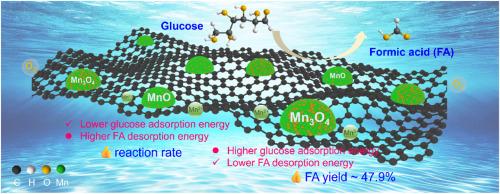Mn-MOF-74碳调控MnxOy催化剂对葡萄糖氧化制甲酸的协同作用
IF 5.8
2区 生物学
Q1 AGRICULTURAL ENGINEERING
引用次数: 0
摘要
葡萄糖催化氧化生成甲酸(FA)是生物质增值的重要途径。金属有机框架(MOF)衍生的碳复合材料为催化剂设计提供了卓越的可调性。本文通过对Mn-MOF-74前驱体碳调控的MnxOy/C催化剂的煅烧气氛和温度的控制,取得了令人满意的葡萄糖- fa转化性能。综合表征表明,碳基体具有协同效应:分散MnxOy纳米颗粒,增强基体可及性;防止Mn浸出,提高稳定性。FA产率由关键参数(Mn2++Mn3+)/Mn价态比和MnxOy粒度的微调决定。结合DFT和实验分析表明,Mn价态决定了反应动力学:Mn3O4表现出葡萄糖吸附能的升高和甲酸(FA)解吸能的降低,而MnO表现出相反的趋势,使活性差异合理化。本研究建立了碳介导的协同策略,用于设计生物质氧化升级中高效的锰基催化剂。本文章由计算机程序翻译,如有差异,请以英文原文为准。

Carbon-regulated MnxOy catalysts from Mn-MOF-74: Synergistic effects on glucose oxidation to formic acid
The catalytic oxidation of glucose to formic acid (FA) represents a crucial route for biomass valorization. Metal–organic framework (MOF)-derived carbon composites offer exceptional tunability for catalyst design. Herein, a series of carbon-regulated MnxOy/C catalysts from Mn-MOF-74 precursors via controlled calcination atmospheres and temperatures, achieving satisfactory performance in glucose-to-FA conversion. Comprehensive characterization reveals that the carbon matrix plays a synergistic effect: dispersing MnxOy nanoparticles to enhance substrate accessibility, and preventing Mn leaching to improve stability. The FA yield is determined by fine-tuning key parameters: the (Mn2++Mn3+)/Mn valence ratio and MnxOy particle size. Combined DFT and experimental analyses demonstrate that Mn valence states determine reaction kinetics: Mn3O4 exhibits elevated glucose adsorption energy and reduced formic acid (FA) desorption energy, while MnO displays an opposing trend, rationalizing the activity differences. This work establishes a carbon-mediated synergy strategy for designing efficient Mn-based catalysts in biomass oxidation upgrading.
求助全文
通过发布文献求助,成功后即可免费获取论文全文。
去求助
来源期刊

Biomass & Bioenergy
工程技术-能源与燃料
CiteScore
11.50
自引率
3.30%
发文量
258
审稿时长
60 days
期刊介绍:
Biomass & Bioenergy is an international journal publishing original research papers and short communications, review articles and case studies on biological resources, chemical and biological processes, and biomass products for new renewable sources of energy and materials.
The scope of the journal extends to the environmental, management and economic aspects of biomass and bioenergy.
Key areas covered by the journal:
• Biomass: sources, energy crop production processes, genetic improvements, composition. Please note that research on these biomass subjects must be linked directly to bioenergy generation.
• Biological Residues: residues/rests from agricultural production, forestry and plantations (palm, sugar etc), processing industries, and municipal sources (MSW). Papers on the use of biomass residues through innovative processes/technological novelty and/or consideration of feedstock/system sustainability (or unsustainability) are welcomed. However waste treatment processes and pollution control or mitigation which are only tangentially related to bioenergy are not in the scope of the journal, as they are more suited to publications in the environmental arena. Papers that describe conventional waste streams (ie well described in existing literature) that do not empirically address ''new'' added value from the process are not suitable for submission to the journal.
• Bioenergy Processes: fermentations, thermochemical conversions, liquid and gaseous fuels, and petrochemical substitutes
• Bioenergy Utilization: direct combustion, gasification, electricity production, chemical processes, and by-product remediation
• Biomass and the Environment: carbon cycle, the net energy efficiency of bioenergy systems, assessment of sustainability, and biodiversity issues.
 求助内容:
求助内容: 应助结果提醒方式:
应助结果提醒方式:


